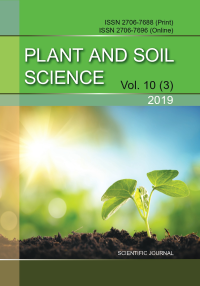The influence of stubble biodestructor on the southern chernozem microbiological activity
DOI:
https://doi.org/10.31548/agr2019.03.005Keywords:
stubble biodestructor, soil bacterization, micromycetes, nitrogen fixators, peas, spring barleyAbstract
The article presents the results of studies carried out in 2011-2015 for the study of microbiological activity of the southern chernozem, depending on treatment of crop residues of cereals and legumes by the stubble biodestructor in the conditions of southern steppe of Ukraine. It was studied the effect of the biopreparation on the total bacterization of the soil, the number of micromycetes and nitrogen fixators in it. It was determined that before the treatment of peas crop residues by the stubble biodestructor in the soil layer 0 – 10 cm there were 5.3·107 PCs/1 g soil bacteria, and in the layer 10 – 20 cm there were 4.8·107 PCs/ 1 g soil, respectively, 1.8 · 107 and 2.2 · 107 PCs/1 g soil more than the samples after growing spring barley. The treatment of crop residues by stubble biodestructor, on average for precursor cultures led to an increase in the total number of bacteria in the soil on 7.3·107 up to 7.5·107 PCs/1 g of soil or 63.0 up to 66.4% depending on the investigated layer. The use of peas, compared with spring barley, provided a slightly higher microbiological activity of the soil. Thus, the number of nitrogen fixators in the soil layer 0 – 10 cm was higher by 17.8 up to 23.4%, and in the layer 10 – 20 cm it was higher by 20.3 up to 29.0%, depending on the treatment of post-harvest residues.
References
Lykhovyd P.V., Lavrenko S.O. (2017). Vplyv obrobitku gruntu ta mineral'nykh dobryv na biolohichnu aktyvnist' gruntu pid posivamy kukurudzy tsukrovoyi. [Influence of tillage and mineral fertilizers on soil biological activity under sweet corn crops]. Ukrainian Journal of Ecology. 7(4). 18-24. [in Ukrainian].
https://doi.org/10.15421/2017_81
Kots' S. YA., Morgun V. V., Patyka V. F., Datsenko V. K., Krugova E. D., Kirichenko E. V., Mel'nikova N. N., Mikhalkiv L. M. (2010). Biologicheskaya fiksatsiya azota: bobovo-rizobial'nyy simbіoz [Biological nitrogen fixation such as legume-rhizobial symbiosis]: Monografiya v 4-kh t. Tom 1. Kiyev : Logos. 508 s. [in Russian].
Volkohon V. V., Pyrih O. V., Brytan T. Yu. (2017). Spryamovanist' biolohichnykh protsesiv u chornozemi vyluzhenomu pry vyroshchuvannya yachmenyu yaroho za riznykh vydiv i norm dobryv. [Trends in biological processes in leached chernozem under cultivation of spring barley with various species and rates of fertilizers]. Sil's'kohospodars'ka mikrobiolohiya. Vyp. 26. S. 3-12. [in Ukrainian].
https://doi.org/10.35868/1997-3004.28.3-16
Dem'yanyuk O. S., Sherstoboyeva O. V. (2005). Potentsiyna tselyulozolitychna aktyvnist' hruntiv riznykh ahroekosystem Ukrayiny. [Potential cellulolytic activity of Ukrainian soils of different agro-ecosystems]. Ahroekolohichnyy zhurnal. № 2. S. 56-59. [in Ukrainian].
Patyka V. P., Tykhonovych I. A., Filip'yev I. D. (1993). Mikroorhanizmy i al'ternatyvne zemlerobstvo [Microorganisms and alternative agriculture]. K. : Urozhay, 176 s. [in Ukrainian].
Smirnov V. V., Pidhors'kyy V. S., Iutyns'ka H. O., Antypchuk A. F., Patyka V. P. (2002). Mikrobni biotekhnolohiyi v sil's'komu hospodarstvi [Microbial biotechnology in agriculture]. Visnyk ahrarnoyi nauky. № 4. S. 5-9. [in Ukrainian].
Patyka V. P. (1996). Napryamky i koordynatsiya naukovykh doslidzhen' z hruntovoyi mikrobiolohiyi [Coordination and Direction of scientific research in soil Microbiology]. Visnyk ahrarnoyi nauky. № 6. S. 5-9. [in Ukrainian].
Syshchykova O. (2015). Mikrobiolohichna aktyvnist' hruntiv, porushenykh diyal'nistyu pidpryyemstv hirnychodobuvnoyi promyslovosti. [Microbiologic activity of the soils broken by the activity of mining industry enterprises]. Visnyk L'vivs'koho universytetu. Seriya biolohichna. Vypusk 70. S. 173-180. [in Ukrainian].
Bobryk N. Yu., Kryvtsova M. V., Nikolaychuk V. I. (2013). Biolohichna aktyvnist' gruntiv pryzaliznychnykh ekosystem za mikrobiolohichnymy pokaznykamy. [Biological activity of the pre-railway ecosystems soils for microbiological indicators]. Gruntoznavstvo. V. 14 (№1-2). S. 40-48. [in Ukrainian].
Margesin R., Zimmerbauer A., Schinner F. (2000). Monitoring of bioremediation by soil biological activities. Chemosphere. Vol. 40. N 3. Р. 339-340. [in English].
https://doi.org/10.1016/S0045-6535(99)00218-0
Potapenko L. V., Skachok L. M., Horbachenko N. I. (2017). Biolohichna transformatsiya orhanichnoyi rechovyny u dernovo-pidzolystomu grunti za vplyvu systemy udobrennya ta mikrobnykh preparativ. [Biological transformation of the organic substance in the sod-podzolic soil under the influence of fertilization systems and microbial preparations]. Sil's'kohospodars'ka mikrobiolohiya. Vyp. 26. S. 30-36. [in Ukrainian].
Fenliang, F. (2012). Mineral fertilizer alters cellulolytic community structure and suppresses soil cellobiohydrolase activity in a long-term fertilization. Soil Biology and Biochemistry. 55, 70-77. [in English].
https://doi.org/10.1016/j.soilbio.2012.06.008
Korets'kyy O. Ye. (2013). Biolohichna aktyvnist' gruntu u posivakh pshenytsi ozymoyi zalezhno vid poperednykiv u lisostepu Livoberezhnomu. [Biological activity of soil in sowing of winter wheat depending on predecessors in forest-steppe the left-bank]. Visnyk Poltavs'koyi derzhavnoyi ahrarnoyi akademiyi. № 2. S. 146 - 149. [in Ukrainian].
Hamayunova V. V., Kovalenko O. A., Panfilova A. V., Bolokhovs'kyy V. V. (2011). Vplyv biodestruktora sterni na mikrobiolohichni pokaznyky gruntu pislya yachmenyu yaroho zalezhno vid system obrobitku gruntu ta udobrennya. [Influence of the stubble biodestructor on microbiological parameters of soil after spring barley depending on tillage and fertilizer systems]. Zbirnyk naukovykh prats' Vinnyts'koho NAU. №7 (47). S. 7 - 11. [in Ukrainian].
Downloads
Published
Issue
Section
License
Relationship between right holders and users shall be governed by the terms of the license Creative Commons Attribution – non-commercial – Distribution On Same Conditions 4.0 international (CC BY-NC-SA 4.0):https://creativecommons.org/licenses/by-nc-sa/4.0/deed.uk
Authors who publish with this journal agree to the following terms:
- Authors retain copyright and grant the journal right of first publication with the work simultaneously licensed under a Creative Commons Attribution License that allows others to share the work with an acknowledgement of the work's authorship and initial publication in this journal.
- Authors are able to enter into separate, additional contractual arrangements for the non-exclusive distribution of the journal's published version of the work (e.g., post it to an institutional repository or publish it in a book), with an acknowledgement of its initial publication in this journal.
- Authors are permitted and encouraged to post their work online (e.g., in institutional repositories or on their website) prior to and during the submission process, as it can lead to productive exchanges, as well as earlier and greater citation of published work (See The Effect of Open Access).

